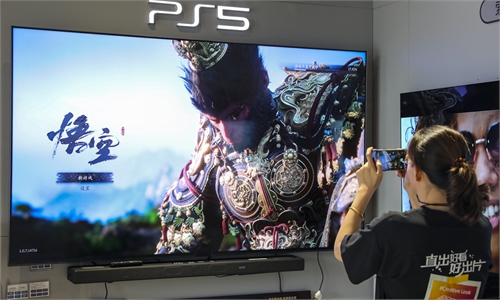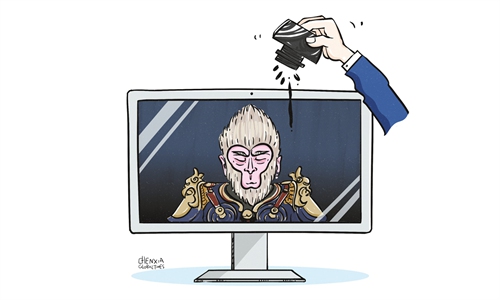ARTS / CULTURE & LEISURE
Fine traditional Chinese culture rides digitization wave overseas

A tribute is paid to the 1986 TV series Journey to the West in Jiyuan, Central China's Henan Province Photo: VCG
Recently, several music pieces themed around Journey to the West have gone viral on social media platforms, both in China and abroad.The theme song from the 1986 TV series Journey to the West, "Yungong Xunyin," has been rearranged, which not only enhances its fantasy feel but also gives it an epic sense of grandeur. Tracks such as "cyber sutra chanting" and Shaanbei-style storytelling have not only ignited passion among young Chinese audiences but have also attracted international listeners.
It can be said that along with the success of China's first triple-A video game Black Myth: Wukong, traditional Chinese music presented through digital means is also making its mark on the global stage.
The reason why these rearranged traditional Chinese music pieces such as "Yungong Xunyin" have garnered such global attention is primarily because they create a rising "digital ambiance." Here, "digital ambiance" refers to the concept of ambiance in traditional literary and artistic works, which, empowered by digital technology, is presented through more vivid and dynamic audiovisual imagery, creating a multi-dimensional and immersive effect. Supporting this "digital ambiance" is the implementation of relevant digital technology used to create "digital scenes," as represented by games like Black Myth: Wukong.
In today's media ecology, which is dominated by mobile internet mediums such as games, short videos, and livestreams, these "digital scenes" not only realize commercial value in the global market but also provide the technical foundation for "digital ambiance," effectively promoting the international dissemination of traditional Chinese culture.
An important but often overlooked step in the creative transformation and innovative development of traditional Chinese culture is its digitization. For instance, through advanced sound technology in "digital scenes" like games, the audio collected from replicas of the Zenghouyi chime bells (an ancient Chinese musical instrument with a history of more than 2,400 years) from the Hubei Provincial Museum can be presented almost in full detail to the public.
Moreover, by digitizing the musical notation of the guqin (an ancient Chinese zither), techniques that were once dependent on a few cultural inheritors can now follow clearer patterns. Through this process, digital technology is helping outstanding traditional Chinese culture, especially Chinese music, explore viable paths for digital transformation. In this light, Black Myth: Wukong offers an excellent example of how traditional Chinese culture can be effectively communicated through digital platforms, achieving meaningful international outreach. In another globally influential Chinese video game, Genshin Impact, the presence of Chinese opera and culinary traditions have both successfully created a melodious "digital ambiance" within the "digital scene" of the game.
As a "digital scene" with millions of daily active interactions, games are playing a crucial role in promoting the digitization of Chinese culture, not only preserving traditional culture in a "living" state but also helping it break through globally. This is a true reflection of modern Chinese civilization.
Currently, digital cultural industries have become the main driving force of China's cultural industry. As the fusion of culture and technology deepens, these industries are leading the charge, helping traditional Chinese culture integrate into modern Chinese civilization through digital means. Since the advent of the new era, China's rapid development in digital technology and infrastructure has spurred the flourishing of industries, including the cultural sector. These digital advancements, driven by market forces, are creating synergies that enhance cultural exchange.
The "digital ambiance" supported by "digital scenes" is promoting high-level dissemination of traditional Chinese culture, both domestically and globally. Through the advocacy of diversity among civilizations, equal dialogue, and mutual respect between different cultures, China is now equipped with new "digital tools" to contribute to the global conversation on civilization.
The author is an associate research fellow at the Central Academy of Culture and Tourism Administration. life@globaltimes.com.cn


